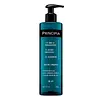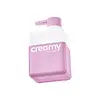What's inside
What's inside
 Key Ingredients
Key Ingredients

 Benefits
Benefits

 Concerns
Concerns

 Ingredients Side-by-side
Ingredients Side-by-side

Water
Skin ConditioningSodium Cocoyl Alaninate
Sodium PCA
HumectantGlycerin
HumectantCocamidopropyl Betaine
CleansingGlyceryl Stearate
EmollientPEG-150 Distearate
EmulsifyingDecyl Glucoside
CleansingPhenoxyethanol
PreservativeCocamide Mipa
EmulsifyingChamomilla Recutita Flower Extract
MaskingCentella Asiatica Extract
CleansingPolysorbate 20
EmulsifyingPotassium Laureth-4 Carboxylate
Hydroxypropyl Guar Hydroxypropyltrimonium Chloride
Propylene Glycol
HumectantPEG-120 Methyl Glucose Trioleate
CleansingSodium Chloride
MaskingPolyacrylate Crosspolymer-6
Emulsion StabilisingTocopheryl Acetate
AntioxidantSodium Gluconate
Skin ConditioningSodium Citrate
BufferingEthylhexylglycerin
Skin ConditioningT-Butyl Alcohol
PerfumingWater, Sodium Cocoyl Alaninate, Sodium PCA, Glycerin, Cocamidopropyl Betaine, Glyceryl Stearate, PEG-150 Distearate, Decyl Glucoside, Phenoxyethanol, Cocamide Mipa, Chamomilla Recutita Flower Extract, Centella Asiatica Extract, Polysorbate 20, Potassium Laureth-4 Carboxylate, Hydroxypropyl Guar Hydroxypropyltrimonium Chloride, Propylene Glycol, PEG-120 Methyl Glucose Trioleate, Sodium Chloride, Polyacrylate Crosspolymer-6, Tocopheryl Acetate, Sodium Gluconate, Sodium Citrate, Ethylhexylglycerin, T-Butyl Alcohol
Ingredients Explained
These ingredients are found in both products.
Ingredients higher up in an ingredient list are typically present in a larger amount.
Cocamidopropyl Betaine is a fatty acid created by mixing similar compounds in coconut oil and dimethylaminopropylamine, a compound with two amino groups.
This ingredient is a surfactant and cleanser. It helps gather the dirt, pollutants, and other impurities in your skin to be washed away. It also helps thicken a product and make the texture more creamy.
Being created from coconut oil means Cocamidopropyl Betaine is hydrating for the skin.
While Cocamidopropyl Betaine was believed to be an allergen, a study from 2012 disproved this. It found two compounds in unpure Cocamidopropyl Betaine to be the irritants: aminoamide and 3-dimethylaminopropylamine. High-grade and pure Cocamidopropyl Betaine did not induce allergic reactions during this study.
Learn more about Cocamidopropyl BetaineDecyl Glucoside is a glucose-based surfactant and emulsion stabilizer. It is created by reacting glucose with the fatty acids from plants.
Surfactants help clean the skin by trapping oil, sebum, and dirt to be washed away. As an emulsion stabilizer, it stabilizes the ingredients in a product by preventing them from separating.
This ingredient is biodegradable and non-toxic. This ingredient is commonly found in baby shampoos.
Decyl Glucoside is sometimes used to stabilize the UV filter Tinosorb.
Learn more about Decyl GlucosideGlycerin is already naturally found in your skin. It helps moisturize and protect your skin.
A study from 2016 found glycerin to be more effective as a humectant than AHAs and hyaluronic acid.
As a humectant, it helps the skin stay hydrated by pulling moisture to your skin. The low molecular weight of glycerin allows it to pull moisture into the deeper layers of your skin.
Hydrated skin improves your skin barrier; Your skin barrier helps protect against irritants and bacteria.
Glycerin has also been found to have antimicrobial and antiviral properties. Due to these properties, glycerin is often used in wound and burn treatments.
In cosmetics, glycerin is usually derived from plants such as soybean or palm. However, it can also be sourced from animals, such as tallow or animal fat.
This ingredient is organic, colorless, odorless, and non-toxic.
Glycerin is the name for this ingredient in American English. British English uses Glycerol/Glycerine.
Learn more about GlycerinPhenoxyethanol is a preservative that has germicide, antimicrobial, and aromatic properties. Studies show that phenoxyethanol can prevent microbial growth. By itself, it has a scent that is similar to that of a rose.
It's often used in formulations along with Caprylyl Glycol to preserve the shelf life of products.
This is the synthetic salt of gluconic acid, a form of PHA and mild exfoliant.
It is mainly used to stabilize oil and butter formulations from going bad. Sodium gluconate is a humectant, pH regulator, and chelating agent.
Chelating agents help neutralize unwanted metals from affecting the formulation.
Sodium gluconate is water-soluble.
Learn more about Sodium GluconateWater. It's the most common cosmetic ingredient of all. You'll usually see it at the top of ingredient lists, meaning that it makes up the largest part of the product.
So why is it so popular? Water most often acts as a solvent - this means that it helps dissolve other ingredients into the formulation.
You'll also recognize water as that liquid we all need to stay alive. If you see this, drink a glass of water. Stay hydrated!
Learn more about Water